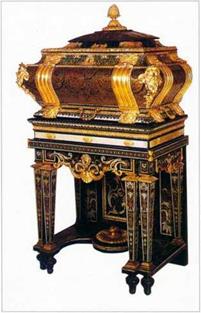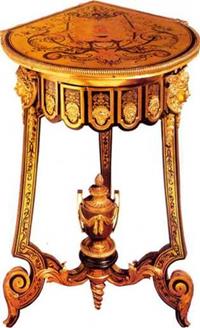1642-1732; EBENISTE. CISELEUR. IX)REUR ETSCULPTEUR DU ROI 1672-1732
|
B |
orn in Paris in 1642. Andre-Charles Boulle was a member of a family originally from Guelder – land in the Netherlands. His father, who for a long time signed his name ‘Jean Bolt’, was himself a ‘menuisier en ebene’ who settled in about 1653 on the hill of Saint-Genevieve. Andre-Charles became a master before 1666. in that year being referred to as ‘maitre menuisier en ebene’ in a legal document. He lived and worked in the rue de Reims near Saint- Etienne-du-Mont. as did his parents. He would seem to have achieved success early in his career, to the extent that he was granted the royal privilege of lodgings in the Galeries du Louvre in 1672. On this occasion Colbert recommended him to the King as ‘the most adept amongst his profession in Paris’. In the same year Boulle received the warrant, signed by the Queen, of ebeniste. ciseleur. doreur et sculpteur du roi’. Like Cucci. therefore. Boulle could pride himself on the title of ‘bronzier’ as well as ebeniste’. and he maintained these two roles throughout his life. In doing this he was infringing the rules of the guilds in force at the beginning of the eighteenth century which forbade the simultaneous practice of two professions. However, his position as ebeniste du roi’ at the Louvre shielded him from prosecution.
This first establishment at the Louvre, formerly occupied by Mace, comprised three mezzanine floors below the Grande Galerie. opening on the ground floor into the rue des Orties. On Colbert’s authorization it was enlarged to include adjoining rooms in 1679. Boulle was obviously doing well. Sometime
113J Armoire/long-case clock in Donjeux <w<l appeared in his sale contrepartie; mentioned in the in 1793.1Wallace Collection,
deed of gift of Boulle to his sons in London I
1715, it was then owned by before 1685 he was also given a second set of rooms on the present site of the Stairway of the Victory of Samothrace comprising three mezzanine floors beneath the Academy of Painting. He expanded still further in 1685. buying a wooden lean-to which abutted onto his second lodgings, giving onto the rue Froidmanteau. Around this outhouse, situated in the courtyards in front of the Louvre between the Place du Vieux-Louvre and the rue Froidmanteau. Boulle erected a number of temporary buildings which served as workshops, wood-stores, storage for furniture and even living quarters.
In 1677 Boulle married Anne-Marie Leroux who was provided with a dowry of 1().(KK) livres. They had seven children, among them the future ebenistes Philippe (1678-1744). Pierre-Benoit (1 (>80-1741). Andre-Charles II (1685-1745), and Charles-Joseph (1688-1754). Boulle’s reputation grew apace. Brice wrote in 1684: ‘He produces works in marquetry, extraordinarily well made, which are treasured by connoisseurs.’ The Livre commode des adresses de Paris for 1691 points out that ‘Boulle produces works in marquetry of a singular beauty’, and in the 1692 edition includes lioulle with Cucci and Lefevre as the only three ebenistes worthy of mention in Paris. From 1672 Boulle had assumed the title of ebeniste’ or ‘mar – queteur ordinaire du roi’ to which he frequently added the title ciseleur’ (bronze-chaser), even on one occasion in 1685 marchand-ebeniste. Despite this he actually supplied very little furniture to Louis XIV. who. one must assume, preferred the work of Cucci. Gole and particularly Gaudron. The only delivery of a piece by Boulle made to the Garde-Meuble Royal took place in 1681: ‘no. 338 – a fine table with marquetry of interlaced gilt-bronze and pewter on a tortoiseshell and ebony ground having five compartments above.
|
|
|
[14j Sarcophagus-shaped coffer known as ‘du Grand Dauphin’. There is a pair to this coffer with a different stand, and a third example at Blenheim. One of them и described in an inventory of the collections of the Grand Dauphin in 1689 and appears to |
|
correspond to a delivery by Boulle in 1684. Tu<o coffers of this type appeared in the Lauraguais sale in 1772and a third in the dealer Julliot’s sale in 1777. (J. Paul Getty Museum, Malibu, California) |
supported by six square tapering legs with gilt-bronze capitals. Length 5 pieds. depth 2 pieds 8 pouces. height 2 pieds 10 pouces. sent to Versailles/ In fact Boulle worked in the service of the Batiments du Roi, making mostly marquetry and parquet floors or decorative details in gilt-bronze (see the accounts of the Batiments cited below) and furniture only as a sideline. Over a period of forty-two years, between 1672 and 1714, he supplied less than twenty pieces of furniture. His first commissions were for the Queen and the Grand Dauphin and he had to wait until 1700 before supplying his first piece to the King. In 1681 his first commission for the Crown was an organ-case for Versailles for the considerable sum of 8,000 livres.
At the same time he created what was to be his masterpiece and make him famous among his contemporaries. the marquetry floors and wainscoting in the Dauphin’s apartments at Versailles. Finished in 1683 at a total cost of nearly 100,000 livres. this decorative ensemble had to be completely dismantled the following year, and moved and adapted for another apartment which the Dauphin took on the ground floor of the Palace. For this new apartment Boulle supplied in 1683 ‘two tables in marquetry as well as a crystal cabinet-stand’ (1.650 livres) and the following year a marquetry coffer (700 livres). which, from the inventor)’ of the Grand Dauphin in 1689, can probably be identified as one of the two coffers now in the J. Paul Getty Museum (14). In 1686 he supplied four fau – teuils and four stools in tortoiseshell and brass marquetry. unique chairs whose appearance may be imagined from a drawing in the Musee des Arts Dec – oratifs. In 17(X), having worked for twenty-eight years for the Batiments Royaux, Boulle supplied a piece of furniture to the King for the first time. This was a large armoire in purplewood for the Garde-Robe du Roi at Marly (1 .(XX) livres). The following year he supplied seven tables for the Menagerie (6.400 livres). the residence the King was having refurbished for the young Duchesse de Bourgogne in the park at Versailles. Lunsingh Scheurleer has identified three entries which probably correspond to these tables:
No. 725) A small table in brass and tortoiseshell marquetry rounded at the front, in the form of a putto astride a dolphin leaning against an anchor, in one hand a trident, in the other a lance. The stand comprises three consoles decorated with the same marquetry anti with a ram’s head above in gilt-bronze, measuring at the back 22 pouces across and 30 deep in the middle.
No. 726) Another small square table with brass and tortoiseshell marquetry with central motifs of a putto on a swing flanked by two further putti and a shepherd playing the bagpipes, the remaining area filled with figural and animal grotesques and ornamental motifs in the same marquetry. 2 pieds 8 pouces in length and 15 pouces in depth.
No. 727) Two small tables also in tortoiseshell and gilt – bronze marquetry with square corners at the back and rounded at the front, designed to be placed in a corner, decorated with garlands and various musical instruments.
marquetry legs and triangular stretcher. 17 pouces wide and 20 deep.
While the table decorated with the swing motif brings to mind the celebrated consoles by Boulle with the same decoration [29]. the two last entries correspond to a type [ 15] by Boulle of which a few rare examples exist (in the Victoria and Albert Museum. Longleat and in a private collection in Paris). In 1708 Boulle supplied two bureaux at a cost of 3.(MX> livres for the King’s Bedchamber at the Grand Trianon. Pierre Ver – let has identified them from the inventory description as two commodes now at Versailles [17]. At this time commodes, a new type of furniture, were still called ‘bureaux’, after the type of furniture from which they derived. Boulle supplied two further ’bureaux’ at a cost of 2,5(X) livres in the same year for the King’s Bedchamber at Marly. Again these were commodes. They remained in Louis XV’s Bedchamber at Marly until 1765 when they were itemized in an inventory as:
No. 527) Two fine commodes in brass and tortoiseshell marquetry with griotte marble tops, each having three large drawers with locks, the escutcheons and handles in gilt-bronze; 1 pied 1 pouce long. 2 pieds deep and 2 pieds 9 pouces high (0*3336).
In 1712 he supplied two desks for Versailles, one in marquetry for the Dauphine (1.025 livres). the second for the King in ’brass and tortoiseshell marquetry enriched with gilt-bronze mounts’ at a cost of 1.250 livres. In 1714. for the first time, the term commode’ appears: Boulle supplied a commode in amaranth at a cost of 1.600 livres for the King’s Bedchamber at Fontainebleau. which is described in an inventory as:
No. 818) A commode in amaranth with mouldings and decoration in gilt-bronze, fitted with three drawers at each end. the front with three fixed panels, the central one with a sunflower; griotte marble top with canted corners. 4 pieds in length. 2 pieds in depth and 32 pouces in height.
In 1715. the year of Louis XlV’s death. Boulle. aged seventy-three years, made over his business and all his assets to his four sons. The workshop continued to supply only a few pieces of furniture to the Crown. During the summer of 1720 a fire broke out one night in the workshops in the courtyard of the Louvre, destroying furniture and part of the collections amassed by Boulle. In 1725 Boulle. no doubt officially recognized to be in declining health, was granted an annual
|
/15/ Table (one of a pair) made described in the royal inventories for the Duchesse de Bourgogne in under the number 727. і Victoria 1701 for the Menagerie with five and Albert Museum. London I others, for a total cost of 6,400/.; |
pension by the King of 500 livres which he drew until the end of 1731. dying in March 1732. The inventory taken after his death reveals that he retained the residue of his possessions which hail survived the fire, including his collection of drawings and prints and particularly the bulk of his bronze models. On the other hand, no furniture on the stocks is mentioned in his workshop and the inventory lists only seven workbenches. His total assets were estimated at 13.053 livres while debts had risen to 20.160 livres (of which
![]() l.(KK) livres was owed to the marchand-joaillicr Thomas-Joachim Hebert, the residue of a bill in 1723 of 3,000 livres, and 5,(XX) livres to the widow of Francois Thome). The sons were therefore forced to auction their father’s assets. According to Mariette. the sale, conducted by the bailiff Sebastien Tesniere in May 1732, lasted a long time and realized 14,914 livres.
l.(KK) livres was owed to the marchand-joaillicr Thomas-Joachim Hebert, the residue of a bill in 1723 of 3,000 livres, and 5,(XX) livres to the widow of Francois Thome). The sons were therefore forced to auction their father’s assets. According to Mariette. the sale, conducted by the bailiff Sebastien Tesniere in May 1732, lasted a long time and realized 14,914 livres.





